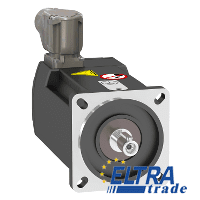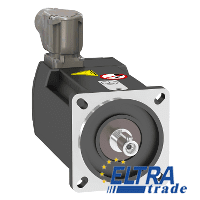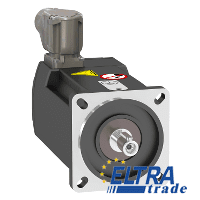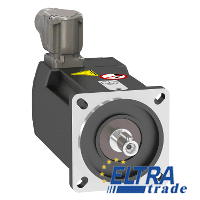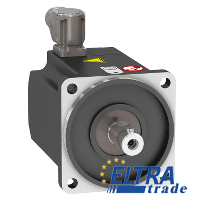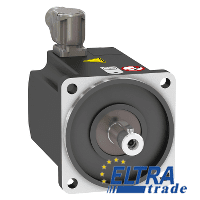Schneider Electric BMP Synchronous motor
| Maximum mechanical speed | 3600 rpm |
| Nominal output power | 2200 W with drive ATV32 at 2.2 kW 400 V three phase |
| Nominal torque | 14.01 N.m with drive ATV32 at 2.2 kW 400 V three phase |
| Nominal speed | 1500 rpm with drive ATV32 at 2.2 kW 400 V three phase |
| Product compatibility | Variable speed drive ATV32 at 2.2 kW 400 V three phase |
| Maximum mechanical speed | 3600 rpm |
| Nominal output power | 2200 W with drive ATV32 at 2.2 kW 200 V single phase 3000 W with drive ATV32 at 4 kW 400 V three phase 3000 W with drive ATV32 at 3 kW 400 V three phase |
| Nominal torque | 9.55 N.m with drive ATV32 at 4 kW 400 V three phase 9.55 N.m with drive ATV32 at 3 kW 400 V three phase 14.01 N.m with drive ATV32 at 2.2 kW 200 V single phase |
| Nominal speed | 3000 rpm with drive ATV32 at 4 kW 400 V three phase 3000 rpm with drive ATV32 at 3 kW 400 V three phase 1500 rpm with drive ATV32 at 2.2 kW 200 V single phase |
| Product compatibility | Variable speed drive ATV32 at 4 kW 400 V three phase Variable speed drive ATV32 at 3 kW 400 V three phase Variable speed drive ATV32 at 2.2 kW 200 V single phase |
| Maximum mechanical speed | 3600 rpm |
| Nominal output power | 370 W with drive ATV32 at 0.37 kW 400 V three phase |
| Nominal torque | 1.18 N.m with drive ATV32 at 0.37 kW 400 V three phase |
| Nominal speed | 3000 rpm with drive ATV32 at 0.37 kW 400 V three phase |
| Product compatibility | Variable speed drive ATV32 at 0.37 kW 400 V three phase |
| Maximum mechanical speed | 3600 rpm |
| Nominal output power | 370 W with drive ATV32 at 0.37 kW 200 V single phase |
| Nominal torque | 1.18 N.m with drive ATV32 at 0.37 kW 200 V single phase |
| Nominal speed | 3000 rpm with drive ATV32 at 0.37 kW 200 V single phase |
| Product compatibility | Variable speed drive ATV32 at 0.37 kW 200 V single phase |
| Maximum mechanical speed | 3600 rpm |
| Nominal output power | 550 W with drive ATV32 at 0.55 kW 400 V three phase |
| Nominal torque | 1.75 N.m with drive ATV32 at 0.55 kW 400 V three phase |
| Nominal speed | 3000 rpm with drive ATV32 at 0.55 kW 400 V three phase |
| Product compatibility | Variable speed drive ATV32 at 0.55 kW 400 V three phase |
| Maximum mechanical speed | 3600 rpm |
| Nominal output power | 550 W with drive ATV32 at 0.55 kW 200 V single phase |
| Nominal torque | 1.75 N.m with drive ATV32 at 0.55 kW 200 V single phase |
| Nominal speed | 3000 rpm with drive ATV32 at 0.55 kW 200 V single phase |
| Product compatibility | Variable speed drive ATV32 at 0.55 kW 200 V single phase |
| Maximum mechanical speed | 3600 rpm |
| Nominal output power | 750 W with drive ATV32 at 1.1 kW 400 V three phase 750 W with drive ATV32 at 0.75 kW 400 V three phase |
| Nominal torque | 2.39 N.m with drive ATV32 at 1.1 kW 400 V three phase 2.39 N.m with drive ATV32 at 0.75 kW 400 V three phase |
| Nominal speed | 3000 rpm with drive ATV32 at 1.1 kW 400 V three phase 3000 rpm with drive ATV32 at 0.75 kW 400 V three phase |
| Product compatibility | Variable speed drive ATV32 at 1.1 kW 400 V three phase Variable speed drive ATV32 at 0.75 kW 400 V three phase |
| Maximum mechanical speed | 3600 rpm |
| Nominal output power | 750 W with drive ATV32 at 0.75 kW 200 V single phase |
| Nominal torque | 2.39 N.m with drive ATV32 at 0.75 kW 200 V single phase |
| Nominal speed | 3000 rpm with drive ATV32 at 0.75 kW 200 V single phase |
| Product compatibility | Variable speed drive ATV32 at 0.75 kW 200 V single phase |
| Maximum mechanical speed | 3600 rpm |
| Nominal output power | 1500 W with drive ATV32 at 1.5 kW 200 V single phase 1100 W with drive ATV32 at 1.1 kW 200 V single phase |
| Nominal torque | 4.77 N.m with drive ATV32 at 1.5 kW 200 V single phase 3.5 N.m with drive ATV32 at 1.1 kW 200 V single phase |
| Nominal speed | 3000 rpm with drive ATV32 at 1.5 kW 200 V single phase 3000 rpm with drive ATV32 at 1.1 kW 200 V single phase |
| Product compatibility | Variable speed drive ATV32 at 1.5 kW 200 V single phase Variable speed drive ATV32 at 1.1 kW 200 V single phase |
In everyday life and in production, the use of electricity predominates. Therefore, most devices and machine tools are powered by electric machines. Many types of units have already been introduced and each has its own qualities. To obtain a constant mechanical force of high power or to generate a huge amount of electricity, synchronous motors are in demand in many areas. Today we will learn the synchronous motor working principle and much more about the BMP line from Schneider Electric.
What is a Schneider Electric BMP Synchronous Motor?
Synchronous motor - a type of electrical machine with an equal frequency of rotation of the shaft and a rotating magnetic field of a fixed assembly. Due to the relatively complex design, such motors are not as common as asynchronous motors, however, in some cases, they are practically indispensable.
So how synchronous motor works? The principle of operation of synchronous electric motors is based on the coupling of the rotating magnetic field of the stator and the constant magnetic field of the rotor. In this case, the concept is the same as that of an asynchronous motor: when a three-phase voltage is applied to the windings of a fixed node, shifted by 1200, a magnetic field arises with alternately changing poles. In this case, a direct current is applied to the rotor windings, which induces a constant magnetic field.
The main difference between a synchronous motor and an asynchronous motor is the principle of converting electrical energy into mechanical rotation. For a synchronous electric motor, the rotor rotation process is identical to the rotation of the working electromagnetic field generated by a three-phase network. But for an asynchronous one, the working field independently induces an EMF in the rotor, which only then generates its own mutual inductance flow and sets the shaft into rotation. As a result, asynchronous electrical machines receive a difference in the rotation of the working field and the load on the shaft, which is expressed by a physical quantity - slip.
Here are the main advantage of BMP motors.
- The elegance of technology
- Compact device for starting an electric motor.
- Allows cabinet size to be reduced by up to 40%.
- High functionality.
- Over 150 built-in application functions.
- Perform the functions of a simple control system.
- Built-in safety features of mechanisms.
- Simple configuration and operation.
- Compatibility of all dialog and configuration tools for Altivar 32 and Lexium 32 frequency converters (SoMove and SoMove Mobile software, remote graphic terminal, loader and multi-loader).
- Various accessories for installation depending on the type of mechanism (vertical, horizontal installation, the ability to rotate the control unit in relation to the power part of the drive (decrease in depth), installation close to each other).
- Interact with most industrial networks.
Design and Construction of Schneider Electric BMP Synchronous Motor
In modern industry and household appliances, synchronous electric motors are used to solve a wide variety of tasks. As a result, their design features also differ significantly. In practice, there are several criteria by which the types of synchronous units are divided. Synchronous motors can be divided according to the following technical characteristics:
- supply voltage;
- operating voltage frequency;
- the number of turns.
Depending on the method of obtaining the rotor field, the following types of synchronous electric motors are distinguished:
- with a field winding on the rotor - the synchronizing force is generated by the power supply from the converter.
- with a magnetic rotor - a permanent magnet is installed on the shaft, which performs the same functions as the excitation winding, but without the need for a recharge.
Installation and Maintenance of Schneider Electric BMP Synchronous Motor
For now, let's look at recommendations for installing and maintaining a synchronous motor BMP.
If the permitted environmental conditions are not observed, foreign substances from the environment may enter the product and cause unintentional movement or damage to the equipment.
- Make sure the environmental conditions are met.
- Do not allow seals to dry out.
- Make sure no liquids come into contact with the shaft sleeve (e.g. in the mounting position IM V3).
- Do not open the shaft seals and the motor cable entries to the direct jet of the pressure washer.
Exceeding the maximum allowable force on the motor shaft will result in premature bearing wear or shaft failure.
- Do not exceed the maximum permitted axial and radial forces on the motor shaft.
- Protect the motor shaft from shock.
- Do not exceed the maximum allowable thrust when pressing components onto the motor shaft.
The temperature of the metal surfaces of the product may exceed 70 °C (158 °F) during operation.
- Avoid unprotected contact with hot surfaces.
- Keep flammable or heat-sensitive parts away from hot surfaces.
- Verify that heat dissipation is sufficient by performing a test run under maximum load conditions.
When the motor is mounted on the mounting surface, it must be perfectly aligned in the axial and radial direction and have uniform contact with the mounting surface. All fixing screws must be tightened to the specified tightening torque. When tightening the fixing screws, uneven mechanical loads must not be applied.
Output components such as pulleys and couplings must be mounted using the correct equipment and tools. The motor and output component must be precisely aligned both axially and radially. If the motor and output components are not aligned exactly, it will cause runout and premature wear.
There are no user-serviceable parts in the engine. Either replace the entire motor or contact Schneider Electric. The product may only be repaired by a Schneider Electric customer service center. The repair cannot be performed with the device installed.
- Use only software and hardware components approved by Schneider Electric for use with this equipment.
- Do not attempt to service this equipment outside of an authorized Schneider Electric service center.
- Update the application every time you change the physical hardware configuration.
Applications of Schneider Electric BMP Synchronous Motor
And now let's find out where the BMP motor is most often used.
- Transport equipment (no more conveyors, lifts, etc.).
- Filling and packaging equipment (bag fillers, marking machines, etc.).
- Special mechanisms (mixers, mixers, automatic lines, etc.), pumping, compressor, and ventilation equipment.
- Woodworking machines, metalworking equipment (bending, welding, etc.).


